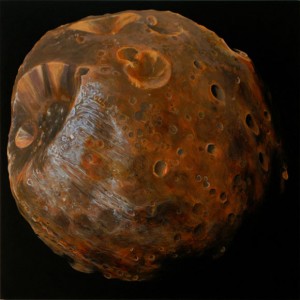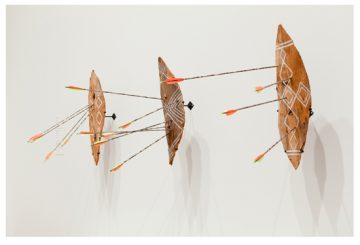Isobel Philip observes the collateral of the space age collected by Adam Norton in his latest show at Gallery 9…
The title of Adam Norton’s show at Gallery 9, Ad Astra or ‘to the stars’ announces the direction of Norton’s gaze; a gaze that moves beyond the Earth’s atmosphere to observe how we ‘know’ space. Outer space is the ultimate unknown. Space (with a capital ‘s’) is navigated through imagination as much as through empirical and meticulously cultivated scientific knowledge. Scientific knowledge, as it stands today, can only go so far. What we don’t know is, for the moment, beyond reach and trapped in the void. Norton plays with the edge of that void.
Acrylic on board, 73x73cms.
Our knowledge of Space is dynamic, not static. The acquisition of such knowledge is a process without an end, for Space itself is continually expanding. In moving ‘to the stars’ we are moving towards something, yet never quite reaching it. It is movement towards an asymptote – a place that certain mathematical graphs approach but never reach.
Norton appropriates this kind of ‘knowing’ both literally and metaphorically, in the form and subject matter of his work. The show is divided into three sections (in individual rooms) that each anatomizes some chapter of the grand Space narrative (a narrative whose plot is both real and imagined). The first room contains a series of painted, mock signs that surround various Space-related sites, including the ‘Extraterrestrial Highway’ that surrounds Area 51 in America. The signs are so fastidiously reproduced that at first glance they appear completely real – as if Norton has simply ripped the originals from the ground. The works in the next room, the Space Flags, are similarly deceitful. Here, Norton’s paintings of various national Space Program logos are pinned up on a single wall as a proclamation of astronomical colonialism – a testament to humanity’s persistent effort to pierce the void.
The third room is lined with portraits of those who have defined how we know space, both imaginatively and empirically with the odd alien thrown in for good measure. Science fiction writer Philip K. Dick hangs next to Sergey Korolyov, the head rocket engineer and designer for the Soviet Union during the 1950s and 1960s.
All of these works are explicitly about space – they literally direct themselves ‘to the stars’. Yet something else is going on here too, something much more implicit, in that the formal structure of these works and their construction metaphorically plays out the ad astra moment. Those signs and space flags that trick the viewer also move towards ‘something’, they approach (but never arrive at) becoming identical to their original subjects. No matter how perfect the likeness is between them, they can never truly become duplicates, following the same logic that governs René Magritte’s painting, The Treachery of Images. The painted pipe can indeed never be a pipe, only a painting of a pipe.
This situation is articulated metaphorically (and explicitly) in The Library of Truth and Fiction, a small installation in the third room. Sitting atop a makeshift bookshelf are two copies of various books (some, but not all, fit within the ‘Space narrative’, including Flying Saucers and Common Sense), one real, the other painted wood. In some cases it is impossible to tell the two apart – the real and the reproduction converge. Here, Norton gets dangerously close to the asymptote, teetering along its edge.
These (non)books are both fictional and nonfictional. Here imagination and scientific knowledge collapse into one another at the intersection of the real and the unreal. The work operates as a microcosm of the entire exhibition in which the boundary between fiction and reality has collapsed. Norton’s exploration of space is calibrated by imagination as much as empirical knowledge, and propelled by both the real and the unreal. He is guided by the words within those books – both the real words and those contained by the fake (wooden) books; the words that don’t exist.




Pingback: Tweets that mention The Edge of the Void | The Art Life -- Topsy.com